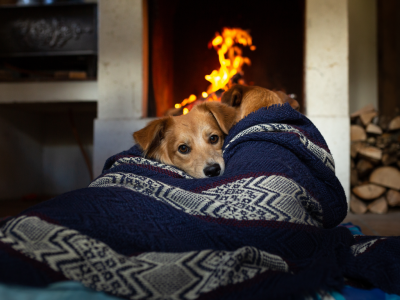
3 Things Every Homeowner Needs to Know About Wood-Burning Fireplaces
Nothing is quite as cozy or welcoming in your home as a wood-burning fireplace. It can ignite nearly all your senses—the fire dances with light and color, the wood smells delicious, the gentle popping and crackling sounds delight your ears, and the flames warm your body and your living space!
Despite the joy that fireplaces can bring, it’s essential to remember that they are an open fire inside your home! So how can you maintain them to ensure safety and efficiency? Follow these steps!
1. Maintenance
Before you light a fire in your fireplace, have it inspected by a professional chimney sweep/inspector and schedule regular cleanings. Check references and be sure your inspector has been certified and has an excellent reputation.
A chimney professional will check how well the fireplace operates, its structural soundness, and make sure the damper and chimney cap/screen is functioning correctly.
Annual cleanings should be done at the end of the cold season to remove creosote buildup, which can cause chimney fires before hot weather and humidity co-mingle with the creosote.
If the creosote becomes thicker than 1/8 of an inch at any point, experts recommend having it cleaned. Creosote accumulation depends on the type of wood you burn, with seasoned hardwood creating less buildup than softer or greener woods.
2. Efficiency
Be sure to close the damper when you’re not using your fireplace, so the warm air in your home doesn’t escape through the chimney. You can also use the damper to control how much air “feeds” your fire and how hot the fire burns.
Likewise, any glass doors should be open when there’s a roaring fire and should be closed when there is no active fire to help reduce heat loss.
Clean out the ashes before they reach the bottom of the grate, which is designed to allow air to flow under your wood and help your wood burn more efficiently. Allowing ash to accumulate too much will hamper both. But it’s okay to leave an inch of ash during the burning season since it serves as insulation.
Seasoned hardwood provides the most efficient heat and will reduce the number of times you have to stop what you are doing to “feed” the fire.
3. Safety
Before your first fire of the season, check to make sure no debris has entered your chimney. Chimney screens and caps help, but a determined bird may have found a way in to build a nest since the last time your flue was cleaned.
When you use your fireplace, make sure combustible items are far from the reach of the flames. Fires can pop and throw sparks onto nearby rugs, children’s clothing, or pets.
Consider adding a fireproof mat to protect the carpet, and use a fire screen to contain random sparks.
Be sure the embers are completely extinguished before dumping ash outside where leaves or debris may ignite. Never use a vacuum cleaner to “clean” ash from a recent fire. Dangerous embers can remain for two or three days!
Do not allow pets or children to play in or near the fireplace. Fireplace tools should also be off limits.
And never start a fire with liquid combustibles. Paper or kindling wood is best.
Be sure you have working smoke detectors and carbon monoxide detectors. And, just in case, keep a fire extinguisher readily available.
A well-maintained and safely handled fireplace can bring a great deal of joy and ambiance into your home while providing an economical source of heat. It’s enough to make you eagerly anticipate colder outdoor temperatures and look forward to sipping tea or hot cocoa while watching a roaring fireplace!
